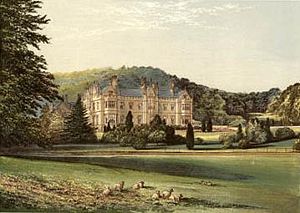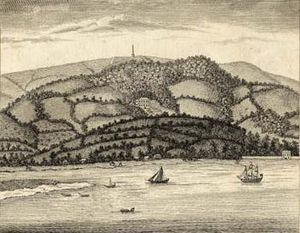- Mamhead
-
Coordinates: 50°37′11″N 3°30′43″W / 50.6197°N 3.5120°W
Mamhead
 Mamhead shown within Devon
Mamhead shown within DevonOS grid reference SX930811 Shire county Devon Region South West Country England Sovereign state United Kingdom Postcode district EX6 Police Devon and Cornwall Fire Devon and Somerset Ambulance South Western EU Parliament South West England List of places: UK • England • Devon Mamhead is a rural village and civil parish near Dawlish and Kenton in Devon, South West England, in the Teignbridge local authority area.
On high ground on the Haldon Hills, dense woodlands open out into views of the coast and the estuary of the River Exe.[1][2]
Contents
History
The village was part of Exminster hundred.[3]
According to Daniel and Samuel Lysons, in their Magna Britannia:[4]
“ It seems most probable that Mamhead House was the royal garrison spoken of by Whitelock as having been abandoned, on the approach of Sir Thomas Fairfax with his army, in the month of January, 1646. It appears to be called Sir Peter Byme's house, by mistake for Sir Peter Balle's for it is spoken of as near Powderham. ” John Marius Wilson's Imperial Gazetteer of England and Wales (1870–1872) says of Mamhead:[5]
“ MAMHEAD, a parish in St. Thomas district, Devon: under Great Haldon hill, 3½ miles W by S of Starcross r. station, and 4 E by N of Chudleigh. Post town, Exeter. Acres, 1,165. Real property, £1,747. Pop., 218. Houses, 40. The property is divided among a few. Mamhead House belonged once to the Balles; was the seat of Sir Robert Newman, who fell at the battle of Inkerman; is now the seat of his brother, Sir Lydston Newman, Bart.; is an edifice in the Tudor style; and stands on a charming spot, commanding a fine seaview. An obelisk of Portland stone, 100 feet high, erected about 1742, by T. Balle, Esq., crowns the summit of a wooded height on the Mamhead grounds. Many spots in the parish are richly picturesque. The living is a rectory in the diocese of Exeter. Value, £200. Patron, Sir L. Newman, Bart. The church is good, and has a tower. Charities, £8. ” The population was 230 in 1801, 178 in 1901. A parish history file is kept at Dawlish Library.[3]
Mamhead Park
The Mamhead estate was sold by the adventurer Sir Peter Carew (1514–1575) to Giles Ball, whose son Sir Peter Ball (1598–1680) was attorney-general to King Charles I's Queen, Henrietta Maria. He began to build a country house here, replacing an older house. His grandson Thomas Ball (1671–1749), a merchant, planted many exotic trees brought back from his travels. Between 1742 and 1745, he built an obelisk on the hill above the house "out of a regard to the safety of such as might use to sail out of the Port of Exon or any others who might be driven on the coast".[1][6] The obelisk has a height of one hundred feet.[7]
In 1823, Mamhead was bought by Robert William Newman (1776–1848), who completely rebuilt the house on a new site in 1827-1833, to the designs of Anthony Salvin. In 1833, Westley Farm was also rebuilt by Salvin.[6] Newman was Member of Parliament for Exeter from 1818 to 1826 and High Sheriff of Devon in 1827. On 17 March 1836, he became Sir Robert William Newman, 1st Baronet, of Mamhead in the County of Devon. The third Baronet was High Sheriff of Devon in 1871. The fourth Baronet represented Exeter in the House of Commons from 1918 to 1931, when he was created Baron Mamhead of Exeter in the County of Devon, in the Peerage of the United Kingdom. The peerage became extinct on his death in 1945, but the baronetcy is still extant.
Mamhead Park became Dawlish College, a boarding school for boys. The building was owned by the Tyler family and run with a staff of approx 20. The usual number of boarders was around 75. The surrounding grounds were utilised for numerous activities from swimming,cricket,football,go karting etc. Dormatories and bathrooms were on the second and third floors. The ground floor was primarily used for the teaching and normal day activities including the school administration. The Camelia room was used as refectory. The Castle housed the science & craft rooms - Physics,Biology,Metalwork,Woodwork and Technical Drawing.The inner courtyard was used for 5-a-side football and Volley ball and also had a changing room area.
It was it this time that the magnificent lead drainage system on the castle roof was removed and sold for scrap value in Exeter. (I seem to recall getting £3 for each item)
It is rumoured that a "white lady" ghost can been seen on the main stair case late at night.
Parish church
The Church of England parish church, dedicated to St Thomas the Apostle, stands in Mamhead Park and is a mostly 15th century building. The chancel was rebuilt about 1830 by Robert William Newman, and the south transept was turned into the Mamhead pew.[6]
Rectors
The Rector of the village from 1766 to 1777 was William Johnson Temple, who is mentioned several times in Boswell's Life of Johnson. He was the grandfather of Frederick Temple (1821–1902), Bishop of Exeter and Archbishop of Canterbury. Temple and Boswell had been undergraduates together at the University of Edinburgh, and Boswell visited Mamhead just after Easter, 1775. Temple was a water-drinker, and under his influence Boswell made a vow under the branches of the great churchyard yew at Mamhead (which can still be seen) never to get drunk again.[6][8]
William Plenderleath (1831–1906) was Rector of Mamhead from 1891 until 1905, and kept notes of the parish, described as "census details (official and unofficial), offertory accounts, list of communions, collections in aid of voluntary church rate, and confirmations. In the front is a linen-backed map showing inhabited houses in Mamhead".[9]
Notes
- ^ a b Fewins, Clive, And so to the tower, via the medieval treacle mines in The Independent dated January 19, 1997, at findarticles.com, accessed 19 July 2008
- ^ Mamhead Park and view to the Exe estuary at flickr.com
- ^ a b Mamhead community page at devon.gov.uk
- ^ Lysons, Daniel and Samuel, Magna Britannia: being a concise topographical account of the several counties of Great Britain Vol. VI., Devonshire (London: T. Cadell, 1822), p. 328
- ^ Descriptive Gazetteer entry for MAMHEAD at visionofbritain.org.uk, accessed 20 July 2008
- ^ a b c d Hoskins, W. G., Devon (1954), extract at devon.gov.uk, accessed 19 July 2008
- ^ View of Mamhead from Exmouth Devon at devon.gov.uk, accessed 19 July 2008
- ^ Naylor, Robert, From John O'Groats to Land's End, page 34 of 42 at ebooksread.com, accessed 19 July 2008
- ^ Notebook belonging to Revd. W.C. Plenderleath containing memoranda relating to the parish of Mamhead, 461 A-1/PI 1 at nationalarchives.gov.uk, accessed 19 July 2008
External links
- Mamhead location map at maps.google.co.uk
- Relationships unit history of MAMHEAD at visionofbritain.org.uk
- Mamhead Park and view to the Exe estuary at flickr.com
- Mamhead Park at British-towns.net
Categories:- Villages in Devon
Wikimedia Foundation. 2010.



